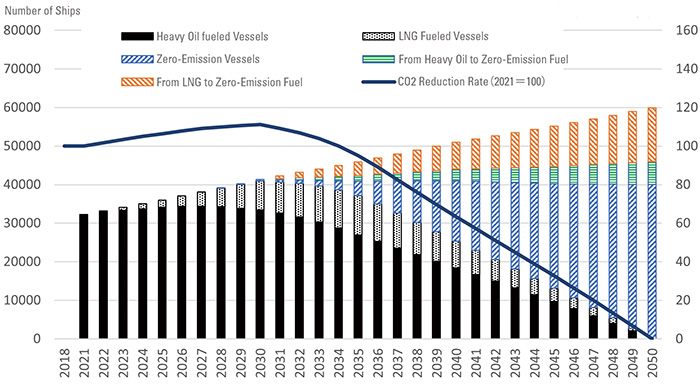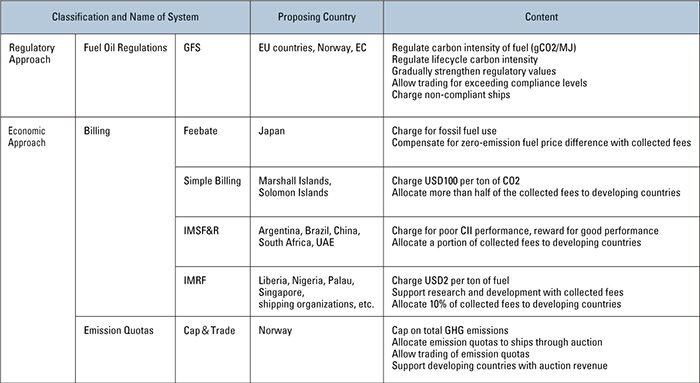Ocean Newsletter
No.541 February 20, 2023
-
Toward Further Expansion and Deepening of the Australia-Japan Relationship
THE HON. Richard MARLES MP (Australian Deputy Prime Minister, Minister for Defence)
Japan and Australia have never been more strategically aligned. We describe Japan as an indispensable partner. Japan and Australia share a deep commitment to democracy, an open economy, and free societies, and we are committed to growing this shared cooperation in the years ahead. The Reciprocal Access Agreement and the Joint Declaration on Security Cooperation, signed by the leaders of Australia and Japan in 2022, will provide a roadmap to take our partnership to a very different place – a better place.
-
The Path to Net Zero Emissions in International Shipping
SAKASHITA Hiroaki (President and CEO, Nippon Kaiji Kyokai (ClassNK))
Japan led the deliberations at IMO, and the shipping sector, ahead of other modes of transport, became the first in the world to adopt international regulations on reducing global warming. Various initiatives - which aim to achieve net zero emissions from international shipping by 2050 - are gaining momentum worldwide. This article introduces the path and current situation until now, as well as what lies ahead further down the road.
-
The Impacts of Hands-on Activities According to the Ocean Literacy Questionnaire
TOMAGO Hisayo (Assistant Professor, Faculty of Law, Chuo University)
Ocean literacy, as presented by members of an association of American marine educators, is defined as "an understanding of the ocean’s influence on you and your influence on the ocean.” This article reports on the impacts of various hands-on activities according to the Ocean Literacy Questionnaire, which was developed and designed from a perspective that considers cultural factors unique to Japan.
The Path to Net Zero Emissions in International Shipping
[KEYWORDS] Decarbonization, International Shipping, Zero Emission ShipsSAKASHITA Hiroaki
President and CEO, Nippon Kaiji Kyokai (ClassNK)
Japan led the deliberations at IMO, and the shipping sector, ahead of other modes of transport, became the first in the world to adopt international regulations on reducing global warming. Various initiatives - which aim to achieve net zero emissions from international shipping by 2050 - are gaining momentum worldwide. This article introduces the path and current situation until now, as well as what lies ahead further down the road.
Progress So Far: Development of International Regulations and Phased Strengthening of Regulations
In the late 2000s, when momentum was building to create a new post-Kyoto Protocol framework, there was an urgent need to establish countermeasures in the international shipping sector, where discussions on global warming countermeasures had lagged behind. Therefore, the Japan Ministry of Land, Infrastructure, Transport and Tourism (MLIT) collaborated with the shipping and shipbuilding industries and classification societies to carefully prepare a feasible framework aimed at contributing to the establishment of global warming countermeasures in the shipping sector, while also intending to enhance industrial competitiveness by leveraging the regulations to be introduced. Japan proposed an amendment to the International Convention for the Prevention of Pollution from Ships (MARPOL), which focuses on the introduction of regulations based on the Energy Efficiency Design Index (EEDI), a fuel efficiency regulation for newly built ships, and led the discussions on this at the International Maritime Organization (IMO). The amendment based on Japan’s proposal was agreed upon, with regulations starting in January 2013 and gradually tightening over time. This marked the world's first introduction of international global warming countermeasure regulations, ahead of other transportation modes.
These regulations did not set targets for greenhouse gas (GHG) reduction. The Paris Agreement, adopted in 2015, served as the new framework for global warming countermeasures after 2020. With the intensifying movement toward zero emissions, in 2018 the IMO adopted the "Initial GHG Reduction Strategy," setting GHG reduction targets and aiming to "reduce CO2 emissions per ton-mile by 40% by 2030 (compared to 2008), reduce GHG emissions by 50% by 2050 (compared to 2008), and pursue zero GHG emissions during this century." To achieve these reduction targets, fuel efficiency regulations for existing ships (Energy Efficiency Existing Ship Index (EEXI) regulations) and Carbon Intensity Indicator (CII) rating systems were introduced in 2023, as the conventional fuel efficiency regulations for new ships alone were insufficient.
Recently, commitments to pursue zero emissions by 2050 have become more active in the government and private sectors, including the shipping sector. Japan announced in 2021 that it aims to achieve "net-zero GHG emissions from international shipping by 2050." Some Japanese shipping companies have also announced their commitment to carbon neutrality by 2050. The international corporate alliance "Getting to Zero Coalition,”* which aims for zero emissions by 2050, started in 2019 and now has over 200 members. Additionally, voluntary initiatives to pursue GHG emission reduction in international shipping have begun in ship finance, insurance, and among cargo owners. The IMO is also advancing discussions on revising the Initial IMO Strategy on Reduction of GHG Emissions from Ships, with a revision scheduled for July 2023. Considering the movements of member countries and industries, it is highly likely that pursuing zero GHG emissions by 2050 will be agreed upon as a new target.
Zero Emission Ships and Fuels
Ships have a long life span of 20 to 30 years, and if zero GHG emissions are to be achieved by 2050, existing ships must be replaced with zero-emission ships starting no later than 2030. Considering the lead time of more than two years from order to completion, the development of zero-emission ships must be completed by the mid-2020s, and there must be clear prospects for procuring zero-emission fuels.
Currently, ammonia, hydrogen, and synthetic methanol are considered potential zero-emission fuels, and numerous development projects for internal combustion engines and ships using these fuels are underway. After going through demonstration projects, technical options are expected to become clearer by the mid-2020s. As for the supply of zero-emission fuels, most of the projects are still in the conceptual stage, but many projects have been launched.
Supporting the Transition to Zero Emissions in International Shipping
Simulations based on scenarios for transitioning to zero emissions by 2050 show that simply replacing end-of-life ships with zero-emission ships from 2028 onwards will not achieve zero emissions by 2050, as ships using heavy oil or LNG fuel will still remain. Therefore, zero-emission targets cannot be achieved by 2050 unless measures are taken to use zero-emission fuels for heavy oil and LNG fuel ships still in service (see figure).
The introduction of zero-emission technologies and fuels in international shipping will lead to increased shipping costs. Currently, energy efficiency improvements are gradually progressing due to energy-saving regulations, and LNG fuel, which reduces CO2 emissions while working towards zero emissions, is being introduced. However, the transition to more expensive zero emissions cannot proceed by relying solely on market forces. Therefore, to ensure a smooth transition, the IMO is currently discussing not only regulatory measures as before, but also economic measures (see table). For regulatory measures, there is a proposal by European countries to regulate GHG emissions per unit heat of fuel, which is supported by many advanced countries, including Japan, as well as the International Chamber of Shipping (an organization composed of national shipowners' associations) and the World Shipping Council (an organization of major liner shipping companies). On the other hand, five proposals are on the table for economic measures, including Japan's proposed fossil fuel tax + subsidies for zero-emission ships.
These frameworks are essential to support investments in zero-emission ships and fuels that entail increased costs, and a swift international agreement is desirable. While the importance of pursuing zero emissions by 2050 is undoubtedly gaining recognition in society, the transition to zero-emission energy in social and economic activities has just begun. The reality is that GHG-free electricity and hydrogen, which can be used to produce zero-emission fuels, are not yet available. The regulatory proposals under discussion at the IMO aim to pursue zero emissions, including in the process of fuel production and distribution, but to ensure a smooth transition, global collaboration among a wide range of stakeholders, such as governments, shippers, shipping companies, shipowners, shipbuilders, marine equipment manufacturers, classification societies, finance, and energy, is crucial.
While the importance of shipping, which supports the daily lives of people around the world, has been reaffirmed amid the COVID-19 pandemic and Russia's invasion of Ukraine, we hope that people worldwide will work together to advance the transition to zero emissions in international shipping for a sustainable future. Nippon Kaiji Kyokai is also deepening its efforts with various partners and intends to play a role in pursuing zero emissions as a third-party certification body. (End)
 Figure: Transition of Ship Composition by Fuel Type and GHG Reduction Rate (Zero Emission Ship Replacement + Zero Emission Fuel Conversion for Operating Ships) (Source: Ministry of Land, Infrastructure, Transport and Tourism)
Figure: Transition of Ship Composition by Fuel Type and GHG Reduction Rate (Zero Emission Ship Replacement + Zero Emission Fuel Conversion for Operating Ships) (Source: Ministry of Land, Infrastructure, Transport and Tourism)
 ■Table: Regulatory and economic measures under discussion at IMO (Source: Ministry of Land, Infrastructure, Transport and Tourism)
■Table: Regulatory and economic measures under discussion at IMO (Source: Ministry of Land, Infrastructure, Transport and Tourism)
- *Getting to Zero Coalition
https://www.globalmaritimeforum.org/getting-to-zero-coalition
